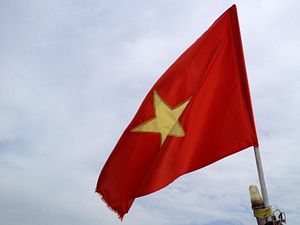The plight of Vietnam’s ethnic groups seems to be weighing heavily on the Communist Party’s mind in recent weeks, with the Politburo stating earlier this month that more action is needed to raise the economic situation of Vietnam’s 53 ethnic minority groups.
“We need to continue to promote the great unity, constantly evoke aspiration, will and national pride among the people,” and make sure that “no one is left behind,” Prime Minister Nguyen Xuan Phuc said on November 18 when addressing a Vietnam National Village for Ethnic Culture Tourism ceremony. Days earlier, the vice-Chairwoman of the National Assembly, Tong Thi Phong, stated that the government “must give priority to providing care for ethnic minority groups in remote, mountainous and extremely disadvantaged areas,” as one state-run newspaper put it.
The focus speaks to a larger challenge for Vietnam. Simply put, as nationwide poverty figures have dramatically reduced since the 2000s, and living standards improved, such progress haven’t been shared by the ethnic groups, who make up around 14 percent of the country’s population but who constituted 73 percent of the poor in 2016, the World Bank has found.
“Most of the rising rural income inequality derives from differences in outcomes between the Kinh majority and ethnic minorities. While it is true that incomes rose for minority households, they grew much slower than for Kinh,” reads one study of income data between 2002 and 2014, referring to the majority ethnicity in Vietnam, the Kinh. The same study found that average incomes for Kinh households were 1.64 times higher than those of minority households in 2002. By 2014, however, they were 2.04 times higher. Meanwhile, minority groups accounted for a quarter of the bottom fifth of income earners in 2002, but in 2014 they accounted for 35.6 percent.
All this is confounded by a widespread aloofness, which often verges on racism, of the Kinh majority towards the ethnic groups. A prevailing sentiment is that they are backwards and undeveloped, and unwilling to change with the times. More serious, the Communist Party sees them as a threat. Many minority groups, especially the Hmong, fought on the American side of the Vietnam War against the communists, and reprisals were common after the conflict ended.
There is also the religious element, given that the party is keen to suppress the kind of autonomy that religious congregations create. One report suggests two thirds of Protestants in Vietnam are members of ethnic minorities. Many are also Catholics. Repression of the minority groups because of their religious activity is, therefore, common. So, too, is economic repression. Confiscation by the state of the ethnic groups’ land is rife, decimating agriculture in many minority areas. Factories that are the most polluting are often set up in ethnic areas, so as not to affect the Kinh majority.
On November 12, one state-run newspaper carried an op-ed written by the former Deputy Minister of Natural Resources and Environment, Dang Hung Vo, in which he reported ethnic villages in northern Vietnam where “the government had already acquired almost all the farmlands in the village” and where “woman beseeched me: ‘We just want back the peaceful life we used to have when we still had land for farming’.”
It is often spoken in muffled tones, but a good number of party officials reckon the Central Highlands and other ethnic areas demand autonomous rule – much like how minority areas in China are given autonomous powers. But, like China’s Tibetans and Uighurs, such autonomous rule could then lead to separatism, even the downfall of the Communist Party, party members fear. Give ear to Lt. Gen. Tran Quang Phuong, Deputy Director of the General Department of Politics, of the Vietnam People’s Army, who wrote in an article for the Communist Review, the party’s theoretical journal, in October, that the Central Highlands:
is always at the forefront of the hostile forces’ “peaceful evolution” strategy and plots of riot and separatism. Basically, they have been plotting to incite the ethnic minority people to establish the so-called “Dega State” in Indochina, separate the Central Highlands from Vietnam, transform the Central Highlands into an “autonomous region”, gradually establish an “independent state”, and create a favourable condition for the ethnic minority people in other regions to effectuate “flashpoints” as a pretext for their intervention in a bid to destabilize our politics, undermine the national great unity block, and eliminate the socialist regime in our country.
It is not hard to detect, here the belief that certain ethnic groups are considered restive, naturally anti-communist, and easily malleable to outside forces (“peaceful evolution” is a party phrase used to be mean desires for political autonomy and change, and often insinuates outside forces are fanning the flames). Indeed, protests and demonstrations against land confiscation are common in ethnic areas, as are demands that the Communist Party stay out of the religious affairs of these groups. But the vast majority want to make ends meet and be left alone, not revolution. Still, as Phuong writes, “we need to raise a sense of vigilance and make sufficient, correct forecasts about the situation in order to opportunely adopt the measures for effectively fighting against and thwarting the hostile forces’ plots and artifices in this area.”
While some party leaders are now preaching tolerance and understanding towards the minority groups (“we owe the ethnic communities a debt of gratitude so large that we can hardly repay it,” Dang Hung Vo wrote) others, possible a larger cohort, think that if this is done wrongly, it could incite separatist and revolutionary demands. The extent to which Hanoi can put aside its own fears and live up to its evocation of providing greater care for ethnic minority groups will be critical in determining its future course in managing its ethnic challenge.

































